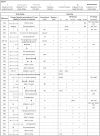Call for standardization in assessment and reporting of muscle and adipose change using computed tomography analysis in oncology: A scoping review
- PMID: 37675809
- PMCID: PMC10570077
- DOI: 10.1002/jcsm.13318
Call for standardization in assessment and reporting of muscle and adipose change using computed tomography analysis in oncology: A scoping review
Abstract
Investigators are increasingly measuring skeletal muscle (SM) and adipose tissue (AT) change during cancer treatment to understand impact on patient outcomes. Recent meta-analyses have reported high heterogeneity in this literature, representing uncertainty in the resulting estimates. Using the setting of palliative-intent chemotherapy as an exemplar, we aimed to systematically summarize the sources of variability among studies evaluating SM and AT change during cancer treatment and propose standards for future studies to enable reliable meta-analysis. Studies that measured computed tomography-defined SM and/or AT change in adult patients during palliative-intent chemotherapy for solid tumours were included, with no date or geographical limiters. Of 2496 publications screened by abstract/title, 83 were reviewed in full text and 38 included for extraction, representing 34 unique cohorts across 8 tumour sites. The timing of baseline measurement was frequently defined as prior to treatment, while endpoint timing ranged from 6 weeks after treatment start to time of progression. Fewer than 50% specified the actual time interval between measurements. Measurement error was infrequently discussed (8/34). A single metric (cm2 /m2 , cm2 or %) was used to describe SM change in 18/34 cohorts, while multiple metrics were presented for 10/34 and no descriptive metrics for 6/34. AT change metrics and sex-specific reporting were available for 10/34 cohorts. Associations between SM loss and overall survival were evaluated in 24 publications, with classification of SM loss ranging from any loss to >14% loss over variable time intervals. Age and sex were the most common covariates, with disease response in 50% of models. Despite a wealth of data and effort, heterogeneity in study design, reporting and statistical analysis hinders evidence synthesis regarding the severity and outcomes of SM and AT change during cancer treatment. Proposed standards for study design include selection of homogenous cohorts, clear definition of baseline/endpoint timing and attention to measurement error. Standard reporting should include baseline SM and AT by sex, actual scan interval, SM and AT change using multiple metrics and visualization of the range of change observed. Reporting by sex would advance understanding of sexual dimorphism in SM and AT change. Evaluating the impact of tissue change on outcomes requires adjustment for relevant covariates and concurrent disease response. Adoption of these standards by researchers and publishers would alter the current paradigm to enable meta-analysis of future studies and move the field towards meaningful application of SM and AT change to clinical care.
Keywords: X-ray computed; body composition; cachexia; chemotherapy; muscular atrophy; neoplasms; tomography.
© 2023 The Authors. Journal of Cachexia, Sarcopenia and Muscle published by Wiley Periodicals LLC.
Conflict of interest statement
The authors declare no conflicts of interest.
Figures





Similar articles
-
The future of Cochrane Neonatal.Early Hum Dev. 2020 Nov;150:105191. doi: 10.1016/j.earlhumdev.2020.105191. Epub 2020 Sep 12. Early Hum Dev. 2020. PMID: 33036834
-
The prognostic value of early onset, CT derived loss of muscle and adipose tissue during chemotherapy in metastatic non-small cell lung cancer.Lung Cancer. 2019 Jul;133:130-135. doi: 10.1016/j.lungcan.2019.05.021. Epub 2019 May 20. Lung Cancer. 2019. PMID: 31200819 Clinical Trial.
-
Telephone interventions for symptom management in adults with cancer.Cochrane Database Syst Rev. 2020 Jun 2;6(6):CD007568. doi: 10.1002/14651858.CD007568.pub2. Cochrane Database Syst Rev. 2020. PMID: 32483832 Free PMC article.
-
Mortality and Morbidity Effects of Long-Term Exposure to Low-Level PM2.5, BC, NO2, and O3: An Analysis of European Cohorts in the ELAPSE Project.Res Rep Health Eff Inst. 2021 Sep;2021(208):1-127. Res Rep Health Eff Inst. 2021. PMID: 36106702 Free PMC article.
-
Improving analysis of sexual dimorphism in body composition dynamics in the oncology setting: A scoping review.Clin Nutr ESPEN. 2025 Jun;67:673-684. doi: 10.1016/j.clnesp.2025.03.169. Epub 2025 Apr 18. Clin Nutr ESPEN. 2025. PMID: 40254164
Cited by
-
CT-derived body composition and differential association with age, TNM stage and systemic inflammation in patients with colon cancer.Sci Rep. 2024 Jul 8;14(1):15673. doi: 10.1038/s41598-024-65871-y. Sci Rep. 2024. PMID: 38977870 Free PMC article.
-
Effect of adipose-related parameters on mortality in patients with liver cirrhosis: a meta-analysis.Ann Med. 2025 Dec;57(1):2473627. doi: 10.1080/07853890.2025.2473627. Epub 2025 Mar 4. Ann Med. 2025. PMID: 40038873 Free PMC article.
-
Diagnosis of Sarcopenia and Myosteatosis by Computed Tomography in Patients with Esophagogastric and Pancreatic Cancer.Cancers (Basel). 2024 Aug 1;16(15):2738. doi: 10.3390/cancers16152738. Cancers (Basel). 2024. PMID: 39123465 Free PMC article.
-
Impact of body composition on prognostic stratification and survival in periampullary carcinoma after pancreatoduodenectomy.Abdom Radiol (NY). 2025 Sep 2. doi: 10.1007/s00261-025-05180-8. Online ahead of print. Abdom Radiol (NY). 2025. PMID: 40892254
References
-
- Shen W, Punyanitya M, Wang ZM, Gallagher D, St.‐Onge MP, Albu J, et al. Total body skeletal muscle and adipose tissue volumes: estimation from a single abdominal cross‐sectional image. J Appl Physiol 2004;97:2333–2338. - PubMed
-
- Mourtzakis M, Prado CMM, Lieffers JR, Reiman T, McCargar LJ, Baracos VE. A practical and precise approach to quantification of body composition in cancer patients using computed tomography images acquired during routine care. Appl Physiol Nutr Metab 2008;33:997–1006. - PubMed
-
- Tan BHL, Birdsell LA, Martin L, Baracos VE, Fearon KCH. Sarcopenia in an overweight or obese patient is an adverse prognostic factor in pancreatic cancer. Clin Cancer Res 2009;15:6973–6979. - PubMed
-
- Baumgartner RN, Koehler KM, Gallagher D, Romero L, Heymsfield SB, Ross RR, et al. Epidemiology of sarcopenia among the elderly in New Mexico. Am J Epidemiol 1998;147:755–763. - PubMed
-
- Martin L, Birdsell L, MacDonald N, Reiman T, Clandinin MT, McCargar LJ, et al. Cancer cachexia in the age of obesity: skeletal muscle depletion is a powerful prognostic factor, independent of body mass index. J Clin Oncol 2013;31:1539–1547. - PubMed
Publication types
MeSH terms
Grants and funding
LinkOut - more resources
Full Text Sources
Medical
Miscellaneous

